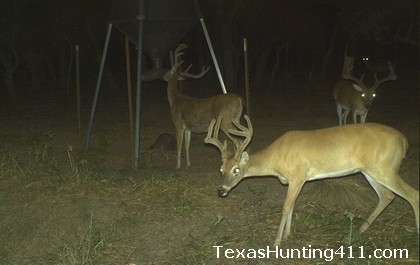Question: “We a protein feeder for deer in Brown County and we are feeding protein pellets with 20 percent protein. We are having trouble with the feeder clogging up due to moisture. The number of deer on our ranch is not hug, but it is respectable with some good quality bucks. We have been feeding protein for the last year now hoping to improve deer health and the whitetail deer hunting on the place. The deer have been using it some, but not eating all of the pellets.
There is mold forming on the north side of the protein feeder barrel. We were recently told that the metal barrels will cause the protein pellets to mold if they are not properly vented. We added some ventilation, but the mold build up has continued, and it is causing the feeder to clog up inside of the barrel. We used a similar feeder on a deer lease a couple years back and we did not have these problems. Do you think the feed dealer is selling us bad protein? Any suggestions or ideas would be appreciated.”

Response: It’s not hard to figure out the problem — moisture. The problem you are facing is likely a combination of many factors. Pelletized feeds, protein pellets for deer included, are all made with some small percent of moisture in them. The problem arises in tightly sealed protein feeders, especially when they heat and cool. The humidity in many parts of Texas only adds to the feeder clogging and moisture build up issues.
When it comes to metal feeders for deer, heat is bad too. Once a deer feeder clogs or begins feeding very slowly, it will start to make it’s own moisture that collects as water droplets on the inside of the lid of your feeder. The rate at which feed moves throughout the feeder will impact moisture and mold development. Low deer numbers or an abundance of natural vegetation means feed will move slow or not at all due to lack of consumption. I suspect the great spring rains in your area, like much of Texas this year, produced a good amount of native food. Deer were not using the protein pellets.
No feed movement means lots of moisture, mold development and problems for you. Once the feeder clogs it is going to keep making moisture everyday. One recommendation: If you use high capacity protein feeders for whitetail deer only put in the amount of feed that they can consume in a month. Feed is expensive, and cleaning out your feeders takes time, so better to put in a little less than a little more when you fill them. The whitetail will be fine if they run out for a few days.
In short, the top layer of protein in the feeder needs to move some everyday. Keep in mind that whitetail deer typically consume much less protein in the spring and during the fall because of many times there will be abundant natural foods. Protein cannot compete with high quality forbs. As the spring green declines deer will turn to protein feeders much more. This is the best time to supplement doe deer for fawn production and the bucks for antler growth that you will benefit from during the deer hunting season. Lastly, place your feeder in a shaded area if at all possible. This will prevent the super-heating of your setup in the Texas sun, reducing the amount of moisture that is given off by the pellets inside the barrel.